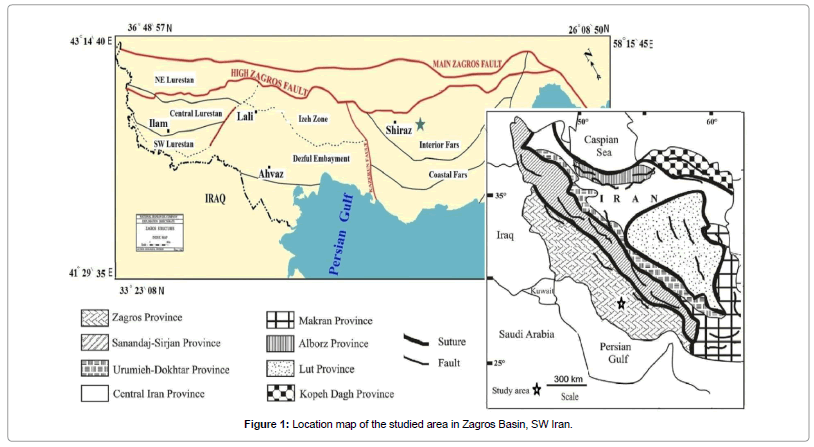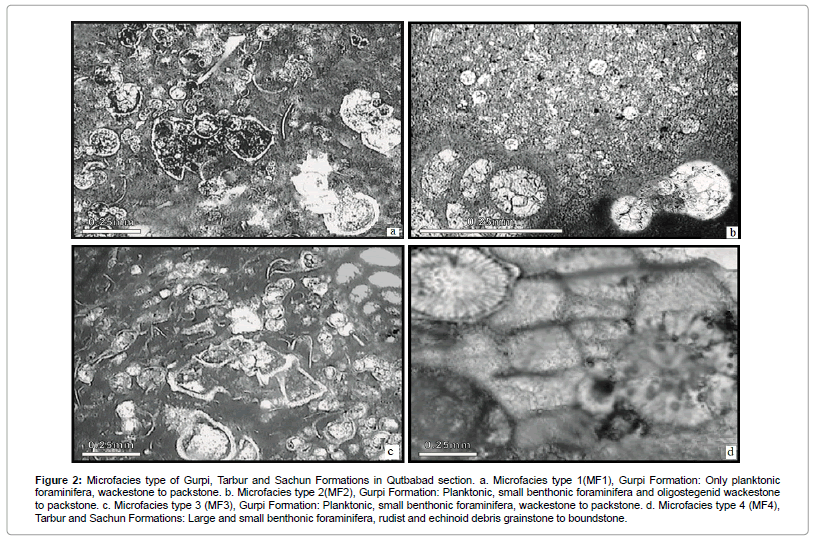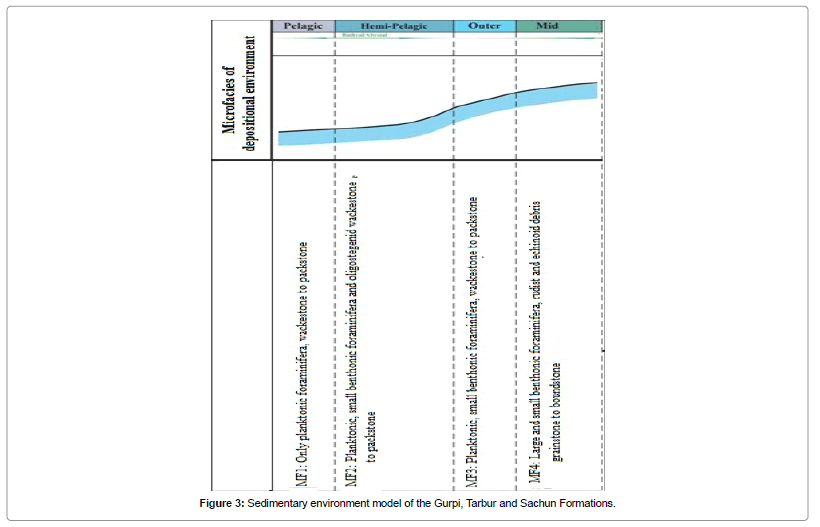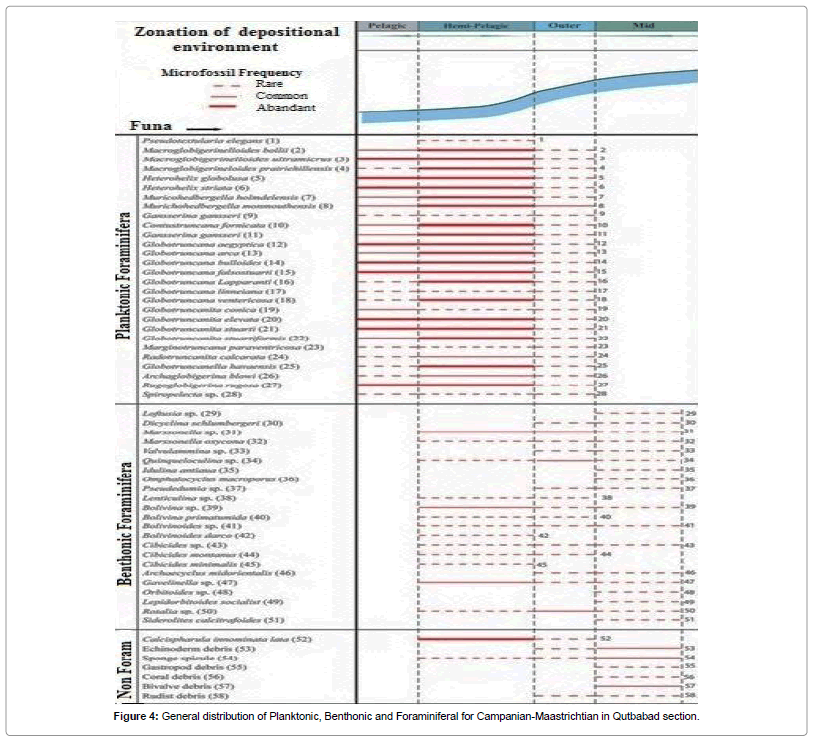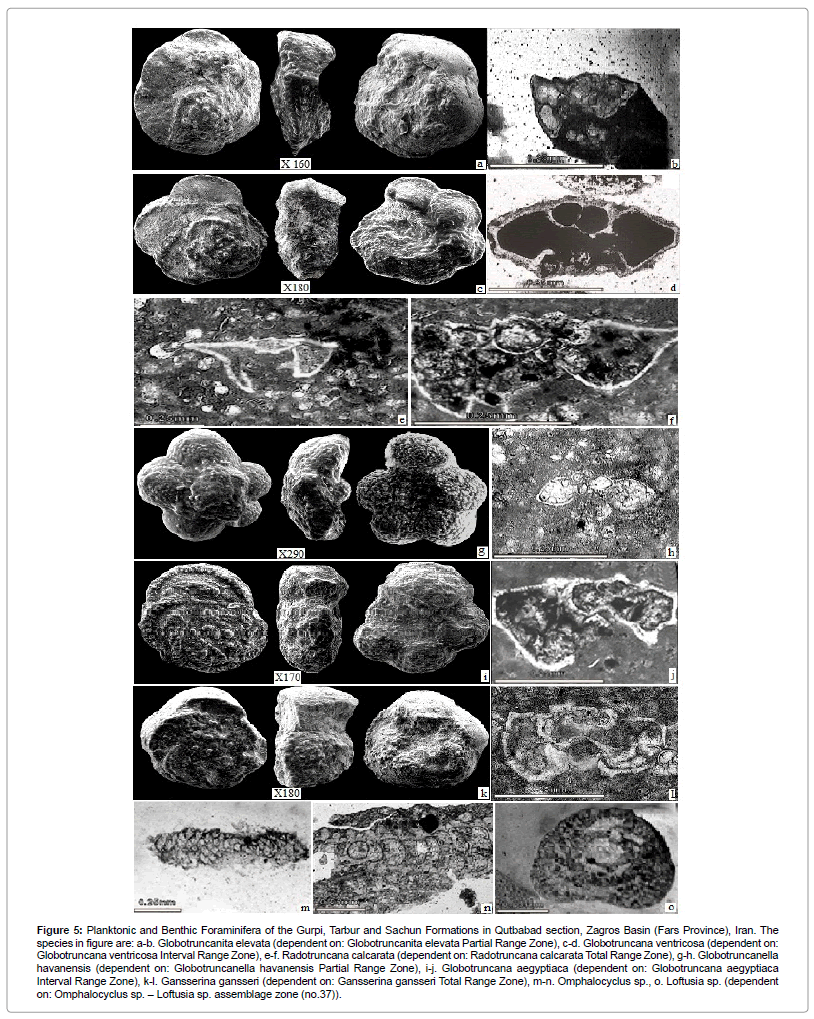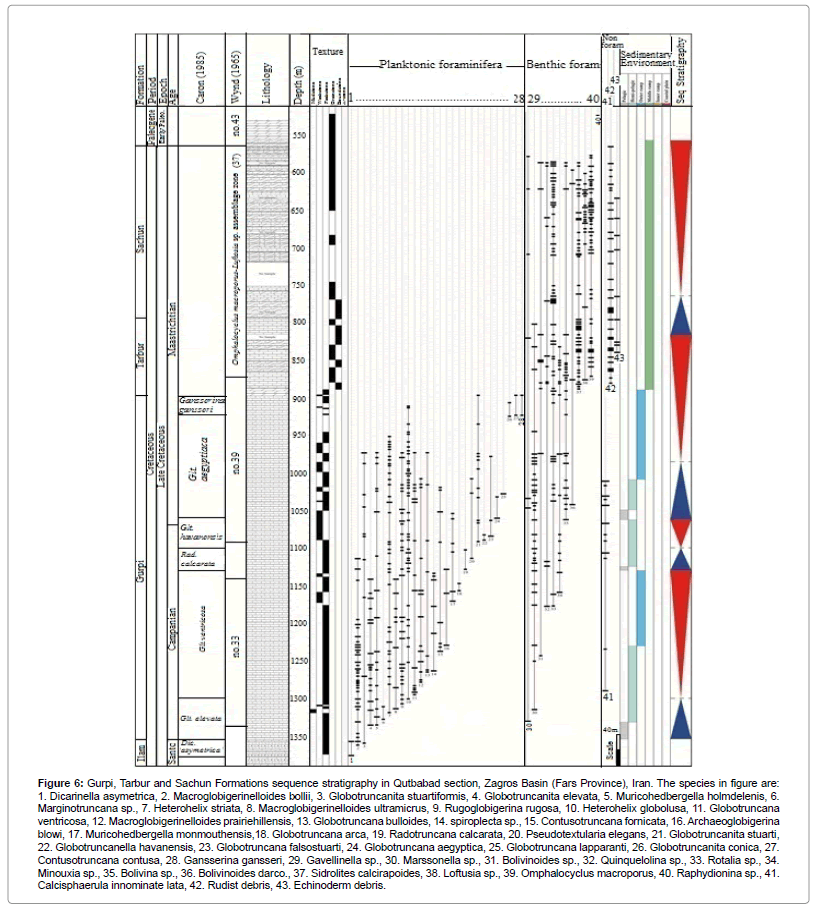Biostratigraphy and Sequence Stratigraphy of Campanian and Maastrichtian Succession, Qutbabad Well, Zagros (Iran)
Received: 23-Oct-2017 / Accepted Date: 23-Feb-2018 / Published Date: 28-Feb-2018 DOI: 10.4172/2157-7617.1000449
Abstract
The Qutbabad section of the Gurpi, Tarbur and Sachun Formations in the Fars Province (Zagros Basin) has been studied, in order to determinate its microfacies and sequence stratigraphy. On the basis of thin section studies of cores from Qutbabad Well in the Gurpi, Tarbur and Sachun Formations of the Zagros Basin, four main microfacies have been recognized within four stratigraphic sequences deposited during the Campanian to Maastrichtian. Depth and sea level changes were the main controls on the distribution of these microfacies. The microfacies are: Pelagic; Hemi-Pelagic; Outer ramp; and Middle ramp. The lowermost sequence was deposited in the Early Campanian-early Late Campanian and includes wackestone to packestone textures with biozones Globotruncanita elevate and Globotruncana ventricosa representative of the Pelagic, Hemipelagic and Outer (ramp/shelf). The intermediate and uppermost sequences (sequence two, three and four) display well developed deposits formed at the end of the Campanian (Radotruncana calcarata zone and Globotruncanella havanensis zone), beginning of the Maastrichtian (Globotruncana aegyptiaca zone and Gansserina gansseri zone) and the end of the Maastrichtian (Omphalocyclus macroporus - loftusia sp assemblage zone) on the Pelagic, Hemipelagic, Outer and Middle ramp. On the basis of the sequence stratigraphic chart, the transgression of the Upper Cretaceous Sea started from the Early Campanian and continued gradually towards the Early Maastrichtian. Then, until the end of Maastrichtian, has had regression. This resulted that the sequence stratigraphic model of the Campanian- Maastrichtian Gurpi, Tarbur and Sachun Formations has architecture similar to those that have developed from global sea level changes.
Keywords: Biostratigraphy; Sequence stratigraphy; Campanian; Maastrichtian
Introduction
The Zagros belt is extending for about 2000 km from eastern Turkey to the Makran in southern Iran. Zagros belt is a section of the Alpe- Himalaya orogenic system and is the largest basin with hydrocarbon reservoir in the world [1]. This basin is located at the collision of the Arabia and Eurasia (Iranian block) shields and includes marine very thick sedimentary rocks that covers Precambrian basement [2,3]. The Gurpi Formation as one of the oil source rocks in this basin has drawn the attention of most geologists since a long time ago [4]. This formation is developed in provinces Lurestan, Khuzestan and Fars, southwest Iran. The Gurpi Formation part of Bangestan group in Fars is considered as one of the oil source rocks of Iran at Qutbabad Well. Gurpi Formation overlies the Ilam Formation with an age of Santonian and overlain by the Tarbur and Sachun Formations with the late Maastrichtian age at the studied section. The type section of Gurpi Formation is chosen in the north Oil field Lali in north-east Masjed-Soleiman with 320 m thickness of argillaceous limestone, shale and marl, and is covered by the Pabdeh Formation and overlies the Ilam Formation. The stratigraphy, microfacies, petroleum geology and sedimentology of the Gurpi Formation were studied by different geologists [5-13]. The type section of Tarbur Formation is chosen in the Gadvan Mountain in north Tarbur village (52°24´05" E and 29°38´01"N) with 527/3 m thickness of limestone and shale and is covered by the Sachun Formation. The microfacies, biostratigraphy and lithostratigraphy of the Tarbur Formation were studied by different Paleontologists [14-16]. The type section of Sachun Formation is chosen in the Sachun Mountain in north Sachun village (54°26´04"E and 28°33´37"N) with 1540 m thickness of Dolomite, Gypsum and Marl. The sedimentology, lithostratigraphy, facies analysis and sequence stratigraphic of the Sachun Formation were studied by different geologists [17-21]. In this study, Gurpi Formation is determined with its 460 meter thickness of argillaceous limestones which conformably overlays limestone of the Ilam Formation and it underlays by Tarbur Formation succession with an erosional disconformity. The Tarbur Formation is determined with its 111 meter thickness of Dolomitic Limestone and Limestone which overlays argillious limestone of the Gurpi Formation and it underlays by Sachun Formation succession. The Sachun Formation is determined with its 350 meter thickness of Dolomitic limestone, Anhydrite and Dolomite succession. The main purpose of this study is to examine biostratigraphy, facies analysis and sequence stratigraphy of the Gurpi, Tarbur and Sachun Formations in a chronostratigraphic and sequence-stratigraphic framework in the Qutbabad section, Fars Province (Interior Fars), Iran.
The Geographical and Geological Setting
The Zagros Basin is structurally one of the eight tectonic/geologic units in Iran. Often, the units are delineated by major boundary faults. These units the following: Zagros Basin, Sanandaj-Sirjan, Urumieh- Dokhtar, Makran, Central Iran, Lut Block, Alborz and Kopeh-Dagh (Figure 1). The basement faults of the Zagros basin had been recorded by many geologists previously [22,23]. The major tectonic events in the geological history of the Zagros took place in the Late Cretaceous to Pliocene time interval [1]. The Zagros Basin is the result of at least two main tectonic events, the first being the beginning of the Neo-Tethys closure, which lead to thrusting in the Late Cretaceous [1], and the second being the final collision, which caused the closure of the Neo- Tethys in the Miocene-Pliocene [24,25]. Therefore, tectonic factors may play a role in creating a sequence stratigraphy in the studied section. Three zones can be distinguished in the Zagros Basin: the Zagros fold-thrust belt, the Zagros imbricate zone (High Zagros) and the Uramieh-Dokhtar zone [26]. The Folded Zagros is subdivided into subzones: Lurestan, Izeh, Dezful Embayment and Fars. The study area (Qutbabad section) is located geologically in the Fars, and about 30 km to the northeast of Jahrum city, southwest Iran. The section was measured in detail at 28°42´34" N and 53°46´45" E.
Materials and Methods
The biostratigraphy examination of Qutbabad Well at the NE Jahrum city was investigated using planktonic foraminifera by means of samples collected in interval of 50 centimetres. The samples include argillious limestone, Dolomitic Limestone and Limestone. The microfacies characteristics were described from thin sections in about 2000 rocky samples that were rich in planktonic foraminifera. In fact, the textural analysis such as grain size, grain composition and funa assemblages reveal microfacies. The classification of microfacies texture is basis on the nomenclature of Danham [27]. References of European on Cretaceous planktonic foraminifera by Caron [28], Premoli Silva and Verga [29] are the basis for the identifications in this study. The abbreviations to be used in this study as: Transgressive System Tract (TST), Maximum Flooding Surface (MFS) and Highstand System Tract (HST).
Results
Microfacies analysis
The interpretation of depositional environment of the Gurpi, Tarbur and Sachun Formations is done by microfacies analysis. The microfacies analyses of all thin sections were observed in microscopic examination. Based on the textural, allochemical and orthochemical characteristics, microfacies types were recognized from formations in this section (Qutbabad section). In classical facies models, a carbonate ramp is divided to Inner, Middle and Outer ramp [30], and an open marine is separated into Pelagic and Hemi-pelagic environments. Microfacies analyses from Qutbabad section of the Gurpi, Tarbur and Sachun Formations, shows Pelagic, Hemi-pelagic, Outer and Middle ramp environments. Palaeoenvironmental reconstruction based on the microfacies approaches a homoclinal carbonate ramp (Middle ramp) to pelagic deep marine environment for Qutbabad section (Figure 2). The microfacies in this section are as below:
Figure 2: Microfacies type of Gurpi, Tarbur and Sachun Formations in Qutbabad section. a. Microfacies type 1(MF1), Gurpi Formation: Only planktonic foraminifera, wackestone to packstone. b. Microfacies type 2(MF2), Gurpi Formation: Planktonic, small benthonic foraminifera and oligostegenid wackestone to packstone. c. Microfacies type 3 (MF3), Gurpi Formation: Planktonic, small benthonic foraminifera, wackestone to packstone. d. Microfacies type 4 (MF4), Tarbur and Sachun Formations: Large and small benthonic foraminifera, rudist and echinoid debris grainstone to boundstone.
Microfacies pelagic (MF1): These facies is dominated by planktonic foraminifera. The existence of only planktonic foraminifera and aboundant gray micrite matrix indicates the deposition of this group in deep sea environment. In fact, the specific faunal assemblage and presence of mud supported textures with high amount of planktonic forams in this facies suggests pelagic environment. Depositional textures are represented by wackestone to pack stone.
Microfacies hemi-pelagic (MF2): The Hemi-pelagic facies (Planktonic, small benthonic foraminifera and oligostegenid wackestone to packstone) consists of bioclasts of plagic foraminifera, oligostegenid and small benthonic foraminifera fragments which indicates Hemi-pelagic marine environment.
Microfacies outer ramp (MF3): This microfacies (Planktonic, small benthonic foraminifera, wackestone to packstone) is mainly Middle ramp bioclasts of planktonic and small benthonic foraminifera without oligostegenid which suggest an outer ramp environment.
Microfacies middle ramp (MF4): Middle ramp facies consists of benthonic foraminifera, rudist and echinoid debris. This facies is generally formed from grainstone which are associated with bound stone. In fact, this faces is characterized by medium grained grainstone to boundstone dominated by large and small benthic foraminifera and other skeletal constituents include bioclasts deriving from rudist and echinoids.
Sedimentary Model
Microfacies analyses from Qutbabad section of Gurpi, Tarbur and Sachun Formations represent the development of a carbonate ramp (Middle and Outer ramp) and open marine environment during the Early Campanian-Late Maastrichtian. The facies model presented here shows a reduce depth from the pelagic, hemipelagic to the middle ramp with distribution of large and small benthonic foraminifera, and other important components (Figures 3 and 4). Wackestone to Pack stone predominate with abundant planktonic foraminifera in the microfacies 1 (MF1). The presence of micrite texture and the apparent absence current structures suggest a low energy environment [30]. In the pelagic and hemi pelagic environments (MF1-MF2), faunal diversity (especially planktonic foraminifera) is high and marine fauna are such as Globotruacona, Globotruncanita, Rugoglobigerina, Muricohedbergella, Macroglobigerinelloides, Heterohelix, Oligostegenid (Calsisphaerula innominata lata) and small foraminifera such as Minouxia sp., Marssonella sp., Miliolid sp., Bolivina sp. The middle ramp setting is represented by the grained foraminiferal and bioclastic grainstone to boundstone dominated by assemblages of larger foraminifera such as Loftusia, Orbitoides, Ompholocyclus, Lepidoribitoides, Siderolites (S. calsitrapoides) and small foraminifera such as Rotalia sp ،Bolivinoides sp ،Bolivina sp., Cibicides sp.
Planktonic and Benthic Foraminifera Bio Zones
Planktonic Foraminifera are abundant and diverse in samples of the Gurpi Formation at the studied section. In this study 15 genera and 28 species of planktonic foraminifera were recognized (Figure 5). Benthic Foraminifera were in this study 12 species in samples of the Tarbur and Sachun Formations at the Qutbabad section. Non Foraminifera are Calcisphaerula innominata lata, Rudist debris and Echinoderm debris. The zonal scheme presented consists of 6 bio zones of zonation of Caron [28] of Gurpi Formation and 1 bio zone (no.37) of zonation Wind [31] for Tarbur and Sachun Formations on the basis of the biostratigraphic distribution of planktonic foraminifera recognized in thin sections. Caron's identified zones [28] of Gurpi Formation are:
Figure 5: Planktonic and Benthic Foraminifera of the Gurpi, Tarbur and Sachun Formations in Qutbabad section, Zagros Basin (Fars Province), Iran. The species in figure are: a-b. Globotruncanita elevata (dependent on: Globotruncanita elevata Partial Range Zone), c-d. Globotruncana ventricosa (dependent on: Globotruncana ventricosa Interval Range Zone), e-f. Radotruncana calcarata (dependent on: Radotruncana calcarata Total Range Zone), g-h. Globotruncanella havanensis (dependent on: Globotruncanella havanensis Partial Range Zone), i-j. Globotruncana aegyptiaca (dependent on: Globotruncana aegyptiaca Interval Range Zone), k-l. Gansserina gansseri (dependent on: Gansserina gansseri Total Range Zone), m-n. Omphalocyclus sp., o. Loftusia sp. (dependent on: Omphalocyclus sp. – Loftusia sp. assemblage zone (no.37)).
Globotruncanita elevata partial range zone: The Globotruncanita elevata partial range zone defines the interval from the last occurrence of all Dicarinella and the first occurrence of Globotruncana ventricosa and corresponds to the Early Campanian (Figure 5). The thickness of the biozone is 53 m. This zone was recorded from Zagros [5] and Tethys [28]. The assemblage includes: Heterohelix striata, Heterohelix globolusa, Globotruncanita stuartiformis, Rugoglobigerina rugosa, Muricohedbergella holmdelenis, Macroglobigerinelloides bollii, Macroglobigerinelloides ultramicrus, Marginotruncana sp., Gavellinella sp., Marssonella sp.
Globotruncana ventricosa interval range zone: This zone defines the stratigraphical interval from first occurrence of Globotruncana ventricosa to the first occurrence of Radotruncana calcarata and corresponds to the late Early Campanian to early Late Campaninan (Figure 5). The thickness of the bio zone is 172 m. This zone was recorded from Tethys [28,32] and is characterized by planktonic foraminiferal species: Heterohelix globolusa, Heterohelix striata, Globotruncana bulloides, Globotruncanita stuartiformis, Rugoglobigerina rugosa, Muricohedbergella holmdelenis, Macroglobigerinelloides prairiehillensis, Contusotruncana fornicata, Macroglobigerinelloides bollii, Muricohedbergella monmouthensis, Globotruncanita elevata, Macroglobigerihelloides ultramicrus, Globotruncana arca, spiroplecta sp., Archaeoglobigerina blowi, Quinquelolina sp., Bolivinoides sp., Rotalia sp., Marssonella sp., Minouxia sp., Calcisphaerula innominata lata.
Radotruncana calcarata total range zone: This zone defines by the total range of Globotruncanita calcarata and corresponds to the late Late Campanian (Figure 5). The thickness of the biozone is 30 m. This zone was recorded from Tethys [28,32] and is characterized by planktonic foraminiferal species: Heterohelix globolusa, Heterohelix striata, Globotruncana bulloides, Globotruncanita stuartiformis, Rugoglobigerina rugosa, Globotruncana ventricosa, Muricohedbergella holmdelensis, pseudotextularia elegans, Macroglobigerinelloides prairiehillensis, Macroglobigerinelloides bollii, Muricohedbergella monmouthensis, Quinquelolina sp., Bolivina sp., Marssonella sp., Minouxia sp., Calcisphaerula innominata lata.
Globotruncanella havanensis partial range zone: The zone is defined as the interval from the last occurrence of Radotruncana calcarata to the first occurrence of Globotruncana aegyptica and corresponds to the early Early Maastrichtian (Figure 5). The thickness of the biozone is 42 m. This zone was recorded from Tethys [28,32] and is characterized by planktonic foraminiferal species: Heterohelix globolusa, Globotruncana falsostuarti, Globotruncanita stuarti, Heterohelix striata, Globotruncana bulloides, Globotrunconita stuartiformis, Rugoglobigerina rugosa, Globotruncana ventricosa, muricohedbergella holmdelensis, Contusotruncana fornicata, Muricohedbergella monmouthensis, Bolivinoides sp., Marssonella sp., Minouxia sp.
Globotruncana aegyptiaca interval range zone: The Globotruncana aegyptiaca zone is defined as the interval from the first occurrence of Globotruncana aegyptiaca to the first occurrence of Gansserina gansseri and corresponds to the Early Maastrichtian (Figure 5). The thickness of the biozone is 134 m. This zone was described from Tethys [28,32] and is characterized by planktonic foraminiferal species: Heterohelix globolusa, Globotruncana falsostuarti, Globotruncanita stuarti, Heterohelix striata, Globotruncana bulloides, Globotruncanita stuartiformis, Rugoglobigerina rugosa, Globotruncana ventricosa, Muricohedbergella holmdelensis, Muricohedbergella monmouthensis, pseudotextularia elegans, Macroglobigerinelloides prairiehillensis, Contusotruncana fornicata, Globotruncana lapparanti, Macroglobigerinelloides bollii, Gavellinella sp., Bolivina sp., Bolivinoides sp., Rotalia sp., Cibicides sp., Marssonella sp., Minouxia sp.
Gansserina gansseri total range zone: This zone defines by the total range of Gansserina gansseri and corresponds to the Late Maastrichtian (Figure 5). The thickness of the biozone is 28 m. This zone was described from Tethys [28,32] and is characterized by planktonic foraminiferal species: Globotruncanita stuarti, Heterohelix globolusa, Globotruncanita conica, Bolivina sp., Rotatia sp.
Discussion
Omphalocyclus sp.-Loftusia sp. assemblage zone (no.37)
Wynd 's identified zone [31] of Tarbur and Sachun Formations is Omphalocyclus sp. – Loftusia sp. assemblage zone (no.37). Abyat [33] introduced the zone for Tarbur Formation as: Omphalocyclus macroporus– Loftusia sp. assemblage zone. The thickness of this biozone is 322 m. The most important assemblage fossils in the biozone are: Valvulammina sp., Bolivina sp., Bolivinoides sp., Rotalia sp., Cibicides sp., Marssonella sp., Minouxia sp., Dicyclina sp., Lepidorbitoide socialis, Marsonella oxycona, Idalina antiqua, Dictyoconus sp., Quinquelolina sp., Echinioids sp., spicule Sponge, Gastropoda debris, Coral debris, Rudist debris. The age of zone is Late Maastrichtian (Figure 5).
Sequence stratigraphic interpretation: A sequence stratigraphic framework includes unites that resulting from the interplay of accommodation and sedimentation [34]. These are unites of TST (Transgressive System Tract), MFS (Maximum Flooding Surface) and HST (Highstand System Tract) which are bounded by sequence boundary SB1 (a type 1 of sequence boundary) or SB2 (a type 2 of sequence boundary). SB1 is an unconformity, and SB2 is a conformity boundary. The study of vertical variations in the microfacies of formations has shown four sedimentary sequences. In this succession, the lower boundary of sequence, Gurpi Formation is identified by argillious limestone from Ilam Formation by SB2, and upper boundary of Sachun Formation, the end of succession, is recognized by SB1(Figure 6). The sequences stratigraphic are as below:
Figure 6: Gurpi, Tarbur and Sachun Formations sequence stratigraphy in Qutbabad section, Zagros Basin (Fars Province), Iran. The species in figure are: 1. Dicarinella asymetrica, 2. Macroglobigerinelloides bollii, 3. Globotruncanita stuartiformis, 4. Globotruncanita elevata, 5. Muricohedbergella holmdelenis, 6. Marginotruncana sp., 7. Heterohelix striata, 8. Macroglobigerinelloides ultramicrus, 9. Rugoglobigerina rugosa, 10. Heterohelix globolusa, 11. Globotruncana ventricosa, 12. Macroglobigerinelloides prairiehillensis, 13. Globotruncana bulloides, 14. spiroplecta sp., 15. Contusotruncana fornicata, 16. Archaeoglobigerina blowi, 17. Muricohedbergella monmouthensis,18. Globotruncana arca, 19. Radotruncana calcarata, 20. Pseudotextularia elegans, 21. Globotruncanita stuarti, 22. Globotruncanella havanensis, 23. Globotruncana falsostuarti, 24. Globotruncana aegyptica, 25. Globotruncana lapparanti, 26. Globotruncanita conica, 27. Contusotruncana contusa, 28. Gansserina gansseri, 29. Gavellinella sp., 30. Marssonella sp., 31. Bolivinoides sp., 32. Quinquelolina sp., 33. Rotalia sp., 34. Minouxia sp., 35. Bolivina sp., 36. Bolivinoides darco., 37. Sidrolites calcirapoides, 38. Loftusia sp., 39. Omphalocyclus macroporus, 40. Raphydionina sp., 41. Calcisphaerula innominate lata, 42. Rudist debris, 43. Echinoderm debris.
Sequence 1: The sequence one is 225 m thick and Early Campanianearly Late Campanian in age. This sequence can be divided into TST (55 m) and HST (170 m). The TST is characterized by microfacies 1 and 2 with wackestone to packstone textures. The open marine fauna show a rising sea level which equivalent to the TST. The microfacies 2 continuing in HST. The wackestone to packstone of the microfacies 3 (HST) with planktonic and small benthonic foram overlies the microfacies 2. In fact, these sediments (TST and HST) were mostly deposited in a pelagic and hemi-pelagic environment. The upper part of the HST indicate possibly outer ramp with a type 2 sequence boundary (SB2). This sequence of Gurpi Formation has been deposited in interval bio zones of Globotruncanita elevata (Early Campanian) and Globotruncana ventricosa (late Early Campanian to early Late Campaninan) of zonation of Caron [28] equivalent to biozone no.33 (Globotruncanita elevata/ Campanian) of zonation of Wind [31].
Sequence 2: The second sequence is about 68 m thick and late Late Campanian-early Early Maastrichtian in age. This sequence can be divided into TST (30 m) and HST (38 m). This depositional system includes argillious limestone rocks of the microfacies 1 and 2 are interpreted as deposits formed during a period of sea level rise (TST). The wackestone to packstone textures of the microfacies 2 is continuing until end of HST. These sediments were mostly deposited in hemipelagic and are interpreted as deposition of the HST with sequence boundary SB2. This sequence of Gurpi Formation has been deposited in interval biozones of Radotruncana calcarata (late Late Campanian) and Globotruncanella havanensis (early Early Maastrichtian) of zonation of Caron [28].
Sequence 3: The thickness of the third sequence is 242 m and its microfacies can be divided into TST (75 m) and HST (167 m). The age of sequence is Early Maastrichtian. There is a conformity boundary (SB2: type 2 of sequence boundary) at the start of sequence. The microfacies 1, 2 and 3 in the basal part of the sequence are interpreted as TST. This microfacies includes pelagic, hemi-pelagic and outer ramp environments. The microfacies 3 continue in HST with planktonic and small benthonic foram wackestone to packstone. The upper part of the HST indicate middle ramp (microfacies 4) with large and small benthonic foram, rudist and echinoid grainstone to bound stone. There is an unconformity (SB1) at the end sequence. This sequence of Gurpi and Tarbur Formations has been deposited in interval bio zones of Globotruncana aegyptiaca and Gansserina gansseri of zonation of Caron [28] equivalent to bio zones no.39 (Globotruncanita stuarti- Pseudotextularia varians) and lower part of no.37 zone (Omphalocyclus macroporus- loftusia sp.) of zonation of Wind [31].
Sequence 4: The thickness of sequence 4 is 256 m and can be divided into TST (54 m) and HST (202 m). The age of sequence is Late Maastrichtian. The basal part of the sequence is interpreted as the TST. This sequence includes limestone, dolomitic limestone, argillious limestone and anhydritic dolomite deposits of the microfacies 4, deposited in the Middle (ramp/shelf) environment. This microfacies includes large and small benthonic foram, rudist and echinoid with grainstone to boundstone textures. The microfacies 4 in the basal part of the sequence interpreted as TST, and is continues until the end sequence (HST). There is an unconformity or SB1 (type one of sequence boundary). This sequence of Sachun Formation has been deposited in interval biozone of Omphalocyclus macroporus- loftusia sp. assemblage zone (no.37) of zonation of Wind [31].
Conclusion
In this study, the Early Campanian-Late Maastrichtian deposits of the Gurpi, Tarbur and Sachun Formations at the Qutbabad section in the interior Fars in Iran were studied in detail with regard to microfacies, biostratigraphy and sequence stratigraphy. Planktonic foraminifera which are suitable tool of biozonation were used for biostratigraphy leading to accurate time scale of each formation. Based on the obtained planktonic and benthic foraminifera, seven biostratigraphic zones (6 bio zones of zonation of Caron [28] of Gurpi Formation and 1 bio zone of zonation of Wynd [31] for Tarbur and Sachun Formations) are proposed for the Early Campanian to Late Maastrichtian interval in the Qutbabad section. The following zones are proposed: Globotruncanita elevata (Early Campanian), Globotruncana ventricosa (late Early Campanian to early Late Campaninan), Radotruncana calcarata (late Late Campanian), Globotruncanella havanensis (early Early Maastrichtian), Globotruncana aegyptiaca (Early Maastrichtian), Gansserina gansseri (Late Maastrichtian) of zonation of Caron [28] for Gurpi Formation, equivalent to biozones no.33 (Globotruncanita elevata/ Campanian), no.39 (Globotruncanita stuarti- Pseudotextularia varians/ Maastrichtian) of zonation of Wynd [31] and also no.37 zone (Omphalocyclus macroporus- loftusia sp.) of zonation of Wynd [31] for Tarbur and Sachun Formations. On the basis of thin section studies of the formations, 4 main microfacies have been recognized. On the basis of the microfacies, four sequences have been recognized in the Upper Cretaceous Qutbabad section of Gurpi, Tarbur and Sachun Formations. These Formations has been deposited in an open marine depositional setting of Pelagic, Hemi-pelagic, Outer and Middle ramp.
References
- Alavi M (2004) Regional stratigraphy of the Zagros fold-thrust belt of Iran and proforland evolution. Am J Sci 304: 1-20.
- Al-Husseini MI (2000) Origin of the Arabian plate structures: Amar collision and Najd Rift. Geo Arabia 5: 527-542.
- Lacombe O, Mouthereau F, Kargar S, Meyer B (2006) Late Cenozoic and modern stress fields in the western Fars (Iran): Implications for the tectonic and kinematic evolution of central Zagros. Tectonophysics 25:TC1003.
- Motiei H (2003) Stratigraphy of Zagros. Publication of the Geological Survey of Iran, Tehran, Iran 536 (in Persian)
- James GA, Wynd JG (1965) Stratigraphic nomenclature of Iranian oil consortium agreement area. Am Assoc Petroleum Geologists Bull 49: 282–2245.
- Setudehnia A (1972) Stratigraphic Lexicon of Iran. Union International des Sciences Geologiques, ASIE, southwest Iran.
- Setudehnia A (1978) The Mesozoic sequence in southwest Iran and adjacent areas. J Petroleum Geol 1: 3-42.
- Vaziri-Moghaddam H (2002) Biostratigraphic study of the Ilam and Gurpi formations based on planktonic foraminifera in SE of Shiraz (Iran). J Sci, Islamic Republic of Iran 13: 339–356.
- Ghasemi-Nejad E, Hobbi H, Schiøler P (2006) Dinoflagellate and foraminiferal biostratigraphy of the Gurpi Formation (Upper Santoniane-Upper Maastrichtian), Zagros Mountains, Iran. Cretaceous Research 27: 828-835.
- Darvishzadeh B, Ghasemi-Nejad E, Ghourchaei S, Keller G (2007) Planktonic foraminiferal biostratigraphy and faunal turnover across the Cretaceous-Tertiary boundary in southwestern Iran. J Sci Tehran Univ Islamic Republic of Iran 18: 139-149.
- Hadavi F, Senemari S (2010) Calcareous nannofossils from the Gurpi Formation (Lower Santonian-Maastrichtian), faulted Zagros range, western Shiraz, Iran. Stratigraphy and Geological Correlation 18: 166-178.
- Beiranvand B, Ghasemi-Nejad E, Kamali MR, Ahmadi A (2014) Sequence stratigraphy of the Late Cretaceous–Paleocene Gurpi Formation in southwest Iran. Geo Arabia 19: 89-102.
- Zarei E, Ghasemi-Nejad E (2014) Sedimentary and organic facies investigation of the Gurpi Formation (Campanian–Paleocene) in southwest of Zagros, Iran. Arab J Geosci 7: 4265-4278.
- Maghfouri-Moghadam I, Zarei-Sahamieh R, Ahmadi-Khalaji A. Tahmasbi Z (2009) Microbiostratigraphy of the Tarbur Formation, Zagros Basin, Iran. J Appl Sci 9: 1781-1785.
- Pirbalouti BA, Abyat A (2013) Microbiostratigraphy and lithostratigraphy of the Tarbur Formation in southeast of Shahr-e-kord, Iran. Adv Environmental Biol 7: 3481-3486.
- Afghah M, Yaghmour S (2014) Biostratigraphy study of Tarbur Formation (upper cretaceous) in Tang-E Kushk and east of Sarvestan (SW of Iran). J Earth Sci 25: 263-274.
- Mahboubi A, Moussavi-Harami R, Shabafrooz R (2010) Sequence stratigraphic analysis of carbonate and evaporate of schun formation (Paleogene) at type locality, Fars Region, Zagros Basin, 9th Middle East Geoscience Conference and Exhibition, Manama, Bahrain.
- Shabafrooz R, Mahboubi A, Moussavi-Harami R (2010) Dolomitization and evaporate mineralization of Sachun Formation at type locality (SE Shiraz). Iran J Crystallography Mineralo 17: 609-620.
- Shabafrooz R, Mahboubi A, Moussavi-Harami R, Amiri-Bakhtiar H (2013) Facies analysis and sequence stratigraphy of the evaporite bearing Sachun Formation at the type locality, South East Zagros Basin, Iran. Carbonates and Evaporites 28:457-474.
- Bahrami M, Arzaghi S, Sahraeyan M (2013) Sedimentary basin analysis of Sachun formation in Southwestern Iran: Implication for sedimentary environments and tectonic setting. International Journal of Adv Appl Sci 2: 89-94.
- Arzaghi S, Afghah M (2014) Diagenetic Aspects of the Lower Paleocene Sachun Formation Carbonates, Zagros Basin, Southwestern Iran. J Earth Sci 25: 884-894.
- Dehbozorgi M, Pourkermani M, Arian M, Matkan AA, Motamedi H, et al. (2010) Quantitative analysis of relative tectonic activity in the Sarvestan area, central Zagros, Iran. Geomorphol 121:329-341.
- Burberry CM (2015) The effect of basement fault reactivation on the Triassic-Recent geology of Kurdistan, north Iraq. J Petrol Geol 38: 37-58.
- Glennie KW (2000) Cretaceous tectonic evolution of Arabia’s eastern plate margin: a tale of two oceans. In: Alsharhan AS, Scott RW (Editors) Middle East Models of Jurassic/Cretaceous Carbonate Systems. SEPM Special Publications 69: 9–20.
- Piryaei A, Reijmer John JG, van Buchem Frans SP, Yazdi-Moghadam M, Sadouni J, et al. (2010) The influence of Late Cretaceous tectonic processes on sedimentation patterns along the northeastern Arabian plate margin (Fars Province, SW Iran). Geological Society, London, Special Publications 330: 211-251.
- Alavi M (2007) Structures of the Zagros fold-thrust belt in Iran. Am J Sci 307: 1064–1095.
- Dunham RJ (1962) Classification of carbonate rocks according to depositional texture. American Association of Petroleum Geologist Memories. pp.108-121.
- Caron M (1985) Cretaceous planktic foraminifera. In: Bolli HM, Saunders JB, Perch-Nielsen K (eds) Planktonic Stratigraphy. Cambridge University Press, Cambridge, UK. pp. 11-86.
- Premoli Silva I, Verga D (2004) Practical Manual of Cretaceous Planktonic Foraminifera. In: Verga D, Rettori R (eds) International school on Planktonic Foraminifera: Universities of Perugia and Milano, Tipografiadi di Pontefelcino, 1- Perugia, Italy. p. 283.
- Burchette TP, Wright VP (1992) Carbonate ramp depositional systems. Sedimentary Geology 79: 3-57.
- Wynd JG (1965) Biofacies of the Iranian Oil Consortium Agreement area. Iranian Oil Operating Companies, Geological and Exploration Division, Report 1082: 125 (Unpublished).
- Sliter W (1989) Biostratigraphic zonation for Cretaceous planktonic foraminifers examined in thin section. J Foraminiferal Res 19: 1-19.
- Abyat A, Afghah M, Dehghaniain MS (2007) Environmental stratigraphic comparison of Tarbur Formation in interior Fars and Lorestan. In: 25th Conference on Geological and Mineral Exploration. pp. 77-81.
- Catuneanu O, Abreu V, Bhattacharya JP, Blum MD, Dalrymple RW, et al. (2009) Towards the standardization of sequence stratigraphy. Earth-Science Rev 92:1-33.
Citation: Fazli L, Senemari S (2018) Biostratigraphy and Sequence Stratigraphy of Campanian and Maastrichtian Succession, Qutbabad Well, Zagros (Iran). J Earth Sci Clim Change 9: 449. DOI: 10.4172/2157-7617.1000449
Copyright: © 2018 Fazli L, et al. This is an open-access article distributed under the terms of the Creative Commons Attribution License, which permits unrestricted use, distribution, and reproduction in any medium, provided the original author and source are credited.
Share This Article
Open Access Journals
Article Tools
Article Usage
- Total views: 3634
- [From(publication date): 0-2018 - Apr 23, 2024]
- Breakdown by view type
- HTML page views: 2896
- PDF downloads: 738

